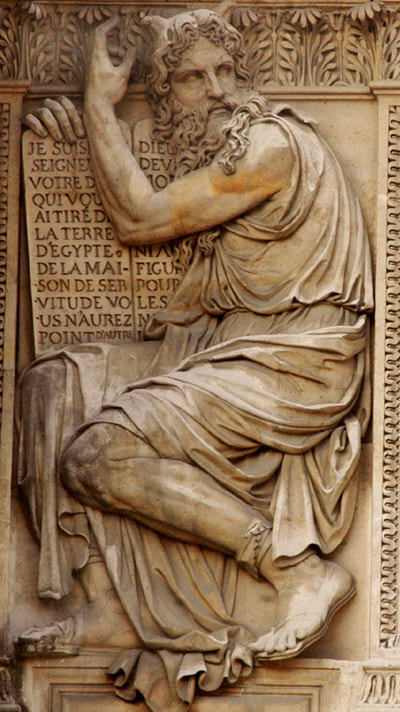2 Corinthians 2:14-3:11 Lesson 343
Read both the "King James Bible" and the "New Living Translation."
In this lesson:
Paul defends his ministry.
Victory through Jesus.
The New Covenant versus the Old Covenant (3:7-11).
This segment runs through verse 7:4 and is referred to as "Paul's major digression."
Without warning, Paul leaves his discussion of Titus and Macedonia to praise God, the
Corinthians, and the ministry. He returns to the topic of Titus in verse 7:5 (lesson 348).
Moses on Aile Lemercier at Musee du Louvre by
French sculptor Jean-Guillaume Moitte (1746-1810).
French sculptor Jean-Guillaume Moitte (1746-1810).
Who was...
Moses
Moses was a prophet of Israel (Deuteronomy 34:10), the author of the first five books in the Old Testament (the Pentateuch), a revered Jewish leader and icon who, with God's help led an estimated 3,000,000 Israelites out of Egyptian bondage to form the Jewish nation.
The son of Amram and Jochebed (Exodus 6:20), Moses was born a Levite (Exodus 2:1) in 1571 BC when the Israelites were enslaved in Egypt (Exodus 1:13-14). Afraid that the growing population of Jewish slaves would one day turn against Egypt (Exodus 1:10), the Egyptian Pharaoh Rameses ordered midwives to kill all the male Jewish babies at birth (Exodus 1:15-16). When the midwives disobeyed (Exodus 1:17), Pharaoh called for the surviving male babies to be "cast into the river" (Exodus 1:22). To save the infant Moses' life, his mother Jochebed hid him in a basket in the reeds on the banks of the Nile River (Exodus 2:3). Pharaoh's daughter found Moses (Exodus 2:5-6) and raised him as her son. Growing up, he received an education (Acts 7:22) and all the advantages given to the son of a king. But at the age of forty, Moses killed an Egyptian he found mistreating a Hebrew (Exodus 2:11-12; Acts 7:23-24) and was forced to flee Egypt. Moses fled to Midian (Exodus 2:15) near Sinai, where he married and lived the simple life of a Shepard (Exodus 3:1) for forty years until God appeared to him in the form of a burning bush (Exodus 3:1-22; Acts 7:30-34). Following God's instructions, the eighty-year-old Moses returned to Egypt to liberate the Israelites. After God brought a series of ten miracles/plagues down on the Egyptians (Exodus 7:1-12:51), Pharaoh allowed the enslaved Israelites to leave Egypt a free people. The Israelites wandered through the wilderness for the next forty years, searching for the Promised Land (Canaan). Moses, "the mediator of the old covenant," received the Mosaic Law (the First Covenant, the Ten Commandments) from God on Mount Sinai (Exodus 34:1-35), prophesied the coming of the Messiah (John 5:46; Acts 7:37), was likened to Christ (Deuteronomy 18:15; Acts 7:37) and appeared with Jesus during the transfiguration (Matthew 17:3-5; Mark 9:2-4; Luke 9:29-30). Moses lived to be one hundred and twenty years old (forty years in the royal palace, forty years as a fugitive in Midian, and forty years in the wilderness) and died on Mount Nebo in Moab (eight miles east of the mouth of the Jordan River) and was buried by God (Deuteronomy 34:5-7). In Jude 1:9, we see Satan arguing with Michael the Archangel over Moses' body. The story of Moses can be found in Exodus, Leviticus, Numbers, and Deuteronomy.
Moses
Moses was a prophet of Israel (Deuteronomy 34:10), the author of the first five books in the Old Testament (the Pentateuch), a revered Jewish leader and icon who, with God's help led an estimated 3,000,000 Israelites out of Egyptian bondage to form the Jewish nation.
The son of Amram and Jochebed (Exodus 6:20), Moses was born a Levite (Exodus 2:1) in 1571 BC when the Israelites were enslaved in Egypt (Exodus 1:13-14). Afraid that the growing population of Jewish slaves would one day turn against Egypt (Exodus 1:10), the Egyptian Pharaoh Rameses ordered midwives to kill all the male Jewish babies at birth (Exodus 1:15-16). When the midwives disobeyed (Exodus 1:17), Pharaoh called for the surviving male babies to be "cast into the river" (Exodus 1:22). To save the infant Moses' life, his mother Jochebed hid him in a basket in the reeds on the banks of the Nile River (Exodus 2:3). Pharaoh's daughter found Moses (Exodus 2:5-6) and raised him as her son. Growing up, he received an education (Acts 7:22) and all the advantages given to the son of a king. But at the age of forty, Moses killed an Egyptian he found mistreating a Hebrew (Exodus 2:11-12; Acts 7:23-24) and was forced to flee Egypt. Moses fled to Midian (Exodus 2:15) near Sinai, where he married and lived the simple life of a Shepard (Exodus 3:1) for forty years until God appeared to him in the form of a burning bush (Exodus 3:1-22; Acts 7:30-34). Following God's instructions, the eighty-year-old Moses returned to Egypt to liberate the Israelites. After God brought a series of ten miracles/plagues down on the Egyptians (Exodus 7:1-12:51), Pharaoh allowed the enslaved Israelites to leave Egypt a free people. The Israelites wandered through the wilderness for the next forty years, searching for the Promised Land (Canaan). Moses, "the mediator of the old covenant," received the Mosaic Law (the First Covenant, the Ten Commandments) from God on Mount Sinai (Exodus 34:1-35), prophesied the coming of the Messiah (John 5:46; Acts 7:37), was likened to Christ (Deuteronomy 18:15; Acts 7:37) and appeared with Jesus during the transfiguration (Matthew 17:3-5; Mark 9:2-4; Luke 9:29-30). Moses lived to be one hundred and twenty years old (forty years in the royal palace, forty years as a fugitive in Midian, and forty years in the wilderness) and died on Mount Nebo in Moab (eight miles east of the mouth of the Jordan River) and was buried by God (Deuteronomy 34:5-7). In Jude 1:9, we see Satan arguing with Michael the Archangel over Moses' body. The story of Moses can be found in Exodus, Leviticus, Numbers, and Deuteronomy.
Study Tip:
Apply Bible lessons to your life.
Apply Bible lessons to your life.












